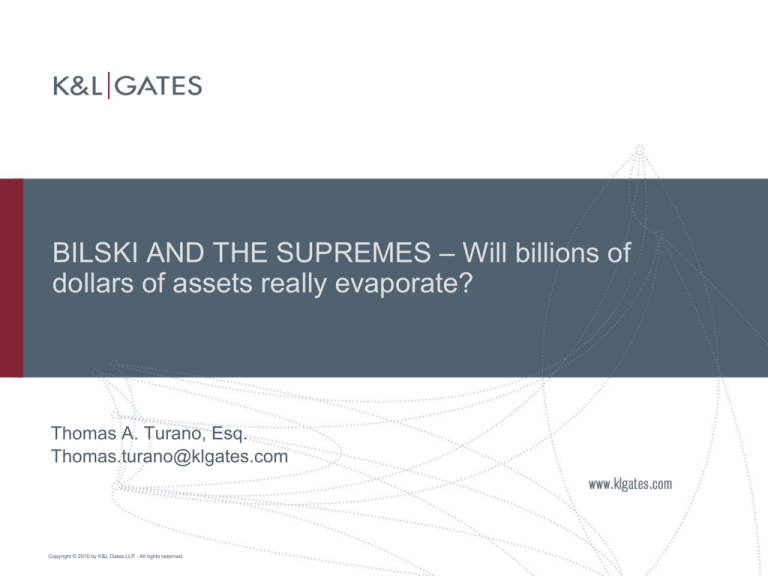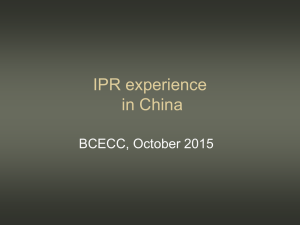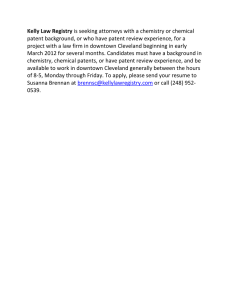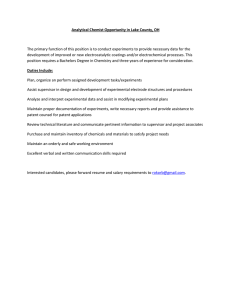
BILSKI AND THE SUPREMES – Will billions of
dollars of assets really evaporate?
Thomas A. Turano, Esq.
Thomas.turano@klgates.com
Copyright © 2010 by K&L Gates LLP. All rights reserved.
Short Answer
Anyone’s guess.
The U.S. Supreme Court is going on recess
shortly and it was expected by many practitioners
that we would have a result by now.
1
Where are we?
Class 705 is the class into which the PTO puts
“business method patents”.
From 2006 to 2008: 27152 applications
were filed in this class.
From 2002-2008: 6152 patents were
granted in this class.
Assuming only $10,000 to file and prosecute
these applications, the total investment in these
cases alone exceeded $330 million.
2
Where are we? (continued)
Taking account the number of businesses which
have been built around these patents and the
number easily extends into the billions.
Further this does not take into account the
numbers of software and other method patents
which have been and may be affected by the
Bilski holding.
3
How did we get here?
1998
State Street Bank & Trust Co. v Signature
Financial Group, Inc
This case is generally credited with opening the
business method patent application flood.
The patent relates to a “Hub and Spoke” structure
of mutual funds whereby assets of the Spokes
and costs are pooled in the Hub and the value of
the asset pool attributable to each Spoke is a
function of the amount of Spoke assets in the
asset pool.
4
How did we get here? (continued)
State Street Bank & Trust (continued)
Simply put, the CAFC reversed the District Court’s
holding that the claims were not directed to
statutory subject matter.
2008
In Re Bernard L. Bilski and Rand A. Warsaw
The claims in Bilski were directed toward a
method of hedging risk in commodities trading.
5
How did we get here? (continued)
In Re Bilski (continued)
In upholding a decision by the Board of Patent
Appeals and Interferences, the CAFC invoked the
U.S. Supreme Court test in Gottschalk v Benson
409 U.S. 63 (1972) that to be patentable under 35
U.S.C. §101 the claimed process must be tied to a
particular machine or apparatus or must transform
a particular article into a different state or thing.
6
How did we get here? (continued)
The claims in Bilski were not directed toward any
specific machine or apparatus and were not
transformative.
The dissent asserted that this was a new
restriction on the kinds of inventions that are
patentable and that the CAFC achieved this result
by redefining the word “process”.
Bilski appealed and the U.S. Supreme Court
accepted cert.
7
The Supreme Court hearing
The transcript makes interesting reading.
From the transcript there appears to be some
confusion among the Justices as to the
distinctions among §§ 101 (statutory subject
matter), 102 (novelty) and 103 (obviousness).
i.e. The questions asked by the Justices appeared
to blur the distinction between whether something
is patentable and whether it should be patented.
8
§101 v § § 102 and 103
§101 is just a definition as to what inventions are
eligible for patenting.
§102 (novelty) and §103 (obviousness) are tests
for whether eligible inventions deserve a patent in
view of what has gone before.
Many inventions are eligible for a patent but are
not patentable because of what has come before.
9
Issues
Policy (pro):
A good deal of money has been spent in
obtaining and using business method patents. To
come to a decision now that these inventions are
not patentable affects not only those who relied on
the patentability of business methods but also
substantially anyone obtaining a patent on
anything. The collateral effect is always the
thought that if patentability under §101 can
change so significantly what is the value of a
patent?
10
Issues (continued)
Policy (con):
Business methods are more abstract than
most patentable inventions. At what point should
such abstract concepts be held by a single
patentee. After all, we do not allow patents on
mathematical formulae or laws of nature.
11
Likely Outcome?
As the saying goes: “Prediction is very difficult,
especially about the future.”
Variously attributed to:
Robert Storm Petersen
Niels Bohr
Samuel Goldwyn and
Yogi Berra
12
Likely outcome (continued)
My assumption is that all business method patents
will not go away.
However, it is likely that any such claims will have
to be written in terms of hardware and strict
methods without a technology nexus will be
unpatentable.
13
Questions
Please do not hesitate to contact me at:
Thomas.Turano@klgates.com
617.261.3148
14
Post eBay – The State of Permanent Injunctions
Tara C. Clancy
Copyright © 2010 by K&L Gates LLP. All rights reserved.
Pre-eBay:
“General Rule”: A permanent injunction should follow upon
proof of infringement of a valid patent. Injunctions denied only
in the “unusual” case, under “exceptional circumstances” and
“ ‘in rare instances … to protect the public interest.’ ”
The theory behind the practice: A patent gives the holder the
right to exclude others.
16
Post-eBay:
“The decision whether to grant or deny injunctive relief rests
within the equitable discretion of the district courts, and that
such discretion must be exercised consistent with traditional
principles of equity, in patent disputes no less than in other
cases governed by such standards.”
eBay v. MercExchange LLC, 547 U.S. 388, 394 (2006).
17
The traditional four-factor test applies:
1. Irreparable injury;
2. Inadequate remedies available at law;
3. Balance of hardships; and
4. Public interest.
eBay v. MercExchange LLC, 547 U.S. 388, 391 (2006).
18
Post-eBay Injunction Rulings
126 district court cases since May 15, 2006.*
Grant of permanent injunction: 72% (91 cases)
Denial of permanent injunction: 28% (35 cases)
*University of Houston Law Center’s Patstats (updated 5/1/2010)
19
Justice Kennedy’s Concurring Opinion
In cases now arising trial courts should bear in mind
that in many instances the nature of the patent being
enforced and the economic function of the patent
holder present considerations quite unlike earlier
cases. An industry has developed in which firms use
patents not as a basis for producing and selling goods
but, instead, primarily for obtaining licensing fees.
eBay v. MercExchange LLC, 547 U.S. 388, 397 (2006)
(Kennedy, J., concurring).
20
Justice Kennedy’s Concurring Opinion
For these firms, an injunction, and the potentially
serious sanctions arising from its violation, can be
employed as a bargaining tool to charge exorbitant
fees to companies that seek to buy licenses to
practice the patent. When the patented invention is
but a small component of the product the companies
seek to produce and the threat of an injunction is
employed simply for undue leverage in negotiations,
legal damages may well be sufficient to
compensate for the infringement and an injunction
may not serve the public interest.
Id.
21
Factors
Patentee Practices Invention
Direct Competition
Willful Infringement
Lost Market Share/Sales Linked to Infringement
Licensing Others
Harm to Reputation
Impact on Infringer’s Business
Public Interest
22
Questions
Please do not hesitate to contact me at:
Tara.Clancy@klgates.com
617.261.3121
23
USER-GENERATED CONTENT
Posters, Bloggers, On-Line Communities
And The Law
David J. Byer
David.Byer@klgates.com
Copyright © 2010 by K&L Gates LLP. All rights reserved.
The Proliferation of User-Generated Content (UGC)
Commercial Sites – Amazon, eBay
Review Sites – TripAdvisor, CNET
YouTube (Viacom v. Google)
LimeWire (Grokster)
Bloggers – commenters
On-line communities: organic, created
UGC can create liability
25
Relevant Law
Copyright Act 17 U.S.C. §§101-810
Trademark Act 15 U.S.C. §§1051-1141; state; common
Defamation and other tort law; state
Advertising Law; state; FTC
Digital Millennium Copyright Act, 17 U.S.C. §512
Communications Decency Act, 47 U.S.C. §230
How to manage liability?
26
Importance of Terms of Use
Enforceability?
- click-wraps
- browse-wraps
Restrictions in Terms of Use
- protection from liability
- create rules and remedies
- implementation for safe harbors/secondary liability
27
Digital Millennium Copyright Act
Copyright Law:
- original expression
- life plus 70 years
- not mere facts or data
- text, graphics, photos, video, music
DMCA:
- Safe Harbor structure: conduit, cache, host, search (§§512(a-d))
- Must: register agent, terminate repeat offenders, implement
notice and takedown, allow standard technical measures
- Can fall out: actual knowledge, red flag context, direct
financial benefit
FAIR USE
28
Trademark Law
No Safe Harbor
Fair Use
Policies, such as ….
Tiffany v. eBay
- must have sufficient knowledge of specific acts
- eBay acted appropriately - structure
29
Communications Decency Act
“No provider of an interactive computer service shall be
treated as the publisher or speaker of any information
provided by another information provider.”
Broad definitions
Pre-empts state tort law – defamation
Does NOT cover intellectual property rights
30
Advertising Law
State regulations
FTC – online advertising guidelines
– Behavioral advertising
– Transparency and consumer control
– Blogger disclosures
31
Questions
Please do not hesitate to contact me at:
David.Byer@klgates.com
617.261.3115
32
Critical Developments in Patent Damages
Thomas F. Holt, Jr.
thomas.holt@klgates.com
Copyright © 2010 by K&L Gates LLP. All rights reserved.
Patent Damages: The Basics
35 USC 284 – Adequate To Compensate For The
Infringement
Lost Profits: Panduit Corp. v. Stahlin Brothers Fibre
Works
Reasonable Royalties: Georgia Pacific Corp v. U.S.
Plywood Corp.
34
Patent Developments: Recent Developments
The Entire Market Value Rule
Application subject to increased scrutiny by the courts
New emphasis on gatekeeper roll of district courts
Evidentiary Standards To Prove Patent Damages
New emphasis on gatekeeper roll of district court
Comparability of prior licenses subject to increased
scrutiny
35
Entire Market Value Rule
What Is The Rule?
The EMV Rule allows a patentee to collect damages on the unpatented
components sold with the patented invention rather than just the
portion due to the patented components, i.e., the entire market value of
the accused product is in play in the damages calculation.
Why Do Plaintiff’s Want To Use It?
Particularly in reasonable royalty cases brought by non-practicing
entities, where the accused product is often a large, complex software
package or electronic device with hundreds of features, the EMV Rule
acts as a huge multiplier on the final damages award
When Can The EMV Rule Be Used?
The EMV Rule can be used when the patented feature is the basis for
customer demand for the accused product that nevertheless contains
other features or is necessary to fully compensate the patentee for the
infringement on his invention
36
Entire Market Value Rule (continued)
Historical Sources
Elizabeth v. Nicholson Pavement Co. – 1877
Garretson v. Clark – 1884
Leading Modern Cases
Marconi Wireless Telegraph Co. v. U.S. - 1942
American Safety Table Co. v. Schreiber - 1969
Rite-Hite v. Kelley - 1995
Tec Air, Inc. v. Denso Mfg, Inc. - 1999
Fonar Corp. v. General Electric Co. - 1999
Recent Decisions
Cornell Univ. v. Hewlett-Packard – March 30, 2009 (May 27, 2008)
Lucent Technologies v. Gateway Inc. – September 11, 2009
IP Innovation v. Red Hat – March 2, 2010
37
Entire Market Value Rule (continued)
The Cornell Case (J. Rader, acting as trial judge, N.D.N.Y.):
Patent covered one component of the Instruction Reorder Buffer
(IRB), which was small part of HP processor, which was small part of
HP “brick”, which was small part of HP server
Plaintiff tried to use EMV Rule using “servers,” then “bricks” as
royalty base
Server base = $38 Billion; “brick” base = $23 Billion; processor base
= $6 Billion
No evidence linking demand for servers or “bricks” to patented
invention
No evidence of a separate market for “bricks”
Smallest saleable unit was processor – which Plaintiff ignored
EMV Rule Rejected – JMOL/Remittitur Granted
38
Entire Market Value Rule (continued)
The Red Hat Case (J. Rader, acting as trial judge, E.D.TX):
Patent covered network switching feature in a LINUX-based
operating system
Accused operating system had 1000 other features
Plaintiff attempted to use EMV Rule by adopting the Operating
System as Royalty Base
EMV Rule rejected by Court because:
No evidence that patented invention drove demand for accused
operating system
Some evidence patented feature was not used at all by some users
Therefore, experts’ proposed testimony excluded
39
Entire Market Value Rule (continued)
The Lucent Case (Fed. Cir., J. Michel):
Patent covered a date-picker tool in Microsoft Outlook
Jury awarded a lump-sum royalty of $358 million
Defense argued in JMOL motion that jury applied the EMV Rule to
reach the $358 million verdict
Court Held That EMV Was Not Appropriate In This Case Because:
No evidence that the patented date-picker tool was the basis – or even a
substantial basis – for consumer demand for Outlook
The patented date-picker tool was a very small component of a much
larger program
Other features of Outlook more important to users
Methodology of Plaintiff’s expert was suspect
40
Evidentiary Standards for Patent Damages
Leading Historical Cases
Del Mar Avionics v. Quinton Instrument Co. - 1987
Grain Processing v. American Maize-Products - 1989
Shockley v. Arcan - 2001
Riles v. Shell Exploration & Production - 2002
Crystal Semiconductor v. Tritech Micro Int’l. - 2005
Integra Lifesciences v Merck – 2005
Recent Decisions
Lucent Technologies v. Microsoft Corp. – September 11, 2009 Patent
ResQNet.com v. Lansa, Inc. – February 5, 2010
IP Innovation v. Red Hat – March 2, 2010
41
Evidentiary Standards for Patent Damages
(continued)
The Lucent Case
No evidence on importance of invention to consumers of
accused product
Minimal evidence regarding how prior licenses related to
patented technology
Some of the prior license evidence was insufficient to
even understand the subject matter – couldn’t even
assess comparability with patented technology at issue
42
Evidentiary Standards for Patent Damages
(continued)
The ResQNet Decision
Five (5) prior license agreements had no relation to
patented technology and encompassed far more than the
hypothetical license being considered in this case, but
were used to inflate the claimed royalty rate
A prior license of the patented technology that arose out
of litigation of the patents-in-suit was not appropriately
considered
43
Evidentiary Standards for Patent Damages
(continued)
The Red Hat Case
Industry statistics on royalty rates were not shown to be
“in any way comparable to the patents-in-suit”
Prior licenses of the patents-in-suit were ignored because
they were ten (10) years ago –no effort to account for
passage of time
“The parties are reminded that expert testimony on topic
of damages will not be allowed absent a firm basis in
accepted economic principles with an eye to the facts of
record”
44
Evidentiary Standards for Patent Damages
(continued)
Take-Aways From Recent Decisions
Focus must be on damages caused by infringement of
claimed invention
“a reasonable royalty analysis requires a court to
hypothesize, not to speculate”
“the damages inquiry must concentrate on compensation for
the economic harm caused by infringement of the claimed
invention”
“the trial court must carefully tie proof of damages to the
claimed inventor’s footprint in the market place.”
45
Evidentiary Standards for Patent Damages
(continued)
Take-Aways From Recent Decisions
Other Licenses Must Be Comparable
Industry wide licensing statistics of little value unless linked
to patented technology by reliable evidence
Licenses of unrelated technology or having additional rights
likely irrelevant
Licenses arising from patent at issue most relevant
Licenses arising from settlements of litigation involving
patented technology could be relevant/open to discovery
All Georgia-Pacific Factors Must Be Tied To The Facts of
the Case
46
Evidentiary Standards for Patent Damages
(continued)
Take-Aways From Recent Decisions
EMV Rule excluded unless proponent shows by reliable
evidence a connection between the market for royalty
base and patented invention, i.e., evidence tending to
provide that the patented technology contributed
substantially to customer demand for that base
47
Questions
Please do not hesitate to contact me at:
Tom.Holt@klgates.com
617.261.3165
48
Inequitable Conduct – Dead or Alive?
John J. Cotter
John.Cotter@klgates.com
Copyright © 2010 by K&L Gates LLP. All rights reserved.
A Statistical View
Between 1/1/2006 and 5/20/2009, out of all CAFC patent-related
opinions:
Inequitable conduct was raised in 48% (64 cases)
Among these 64 cases:
66% - no inequitable conduct
20% - inequitable conduct
14% - remanded
Source: BNA’s Patent, Trademark & Copyright Journal, 79 PTCJ 299, 1/15/2010
Out of all patent cases decided (by district courts and CAFC) in 20082009:
inequitable conduct alleged re 131 patents
29 (22%) found unenforceable
Source: www.patstats.org (University of Houston Law Center)
50
Elements for Inequitable Conduct
Infringer needs to prove by clear and convincing
evidence that
a person substantively involved in the
preparation or prosecution of the patent
affirmatively misrepresented a material fact,
failed to disclose material information, or
submitted false material information
with an intent to deceive the PTO
51
Inequitable Conduct Analysis
Step 1. Infringer must show:
threshold level of materiality and
threshold level of intent
although a greater showing of one allows a lesser
showing of the other.
Step 2. Patent holder can rebut with good faith
explanation to counter evidence of intent to deceive
(e.g., plausible, legitimate reasons for withholding
prior art)
Step 3. Court’s balancing of equities
52
Materiality
Rule 56:
Pre-1992 Amendment
Materiality is determined by reasonable examiner standard
1992 Amendment
Information is material if it is not cumulative to what is already of
record and either establishes “a prima facie case of
unpatentability of a claim” or “refutes, or is inconsistent with”
a position taken during prosecution
However, courts (including the Federal Circuit) continue to apply the
pre-1992 reasonable examiner standard.
53
Intent
Disparities between different panels in the Federal
Circuit on the legal standard for intent:
“Single most reasonable inference”
versus
“Should have known” standard
54
“Single most reasonable inference”
Inferences “must not only be based on sufficient evidence and be
reasonable in light of that evidence, but it must also be the single
most reasonable inference able to be drawn from the evidence
to meet the clear and convincing standard – Star Scientific Inc. v.
R.J. Reynolds Tobacco Co., 537 F.3d 1357 (Fed. Cir. 2008)
Finding no intent to deceive – intent to deceive not the single most reasonable
inference:
Ariad Pharmaceuticals Inc. v. Eli Lilly & Co. Inc., 560 F.3d 1366 (Fed. Cir.
2009)
55
“Should have known”/ “Gross negligence”
Intent may be inferred where a patent applicant knew, or should
have known, that withheld information could be material to the
PTO’s consideration of the patent application - Critikon, Inc. v.
Becton Dickinson Vascular Access, Inc., 120 F.3d 1253 (Fed. Cir.
1997)
Finding of inequitable conduct affirmed based on:
Failure by patent attorney to investigate sale of the invention –
Brasseler, U.S.A. I, L.P. v. Stryker Sales Corp., 267 F.3d 137
(Fed. Cir. 2001)
Failure to disclose to the PTO that several declarations submitted
to support patentability were from paid consultants – Ferring B.V.
v. Barr Laboratories, Inc., 437 F.3d 1181 (Fed. Cir. 2006)
Misrepresentation in declaration regarding dosage information Aventis Pharma S.A. v. Amphastar Pharmaceuticals Inc., 525 F.3d
1334 (Fed. Cir. 2008)
Failure to disclose highly material prior art - PraxAir Inc. v. ATMI
Inc., 543 F.3d 1306 (Fed. Cir. 2008)
56
Good Faith Evidence
Larson Manufacturing Co. v. Aluminart Products Ltd., 559 F.3d. 1317 (Fed.
Cir. 2009) – Federal Circuit regarded Larson’s notification to the
Reexamination Panel of the simultaneous prosecution of related application,
and disclosure of court documents in a related litigation, including Aluminart's
allegations of inequitable conduct, as evidence of good faith
57
Recent Fed. Cir. cases
Do not need “wholly distinct facts” to show intent versus
materiality; intent properly inferred from disclosing and
distinguishing double top stitch while withholding closer stitch Taltech Ltd. v. Esquel Enters. Ltd., No. 2009-1344 (Fed. Cir.
May 12, 2010).
Late disclosure (during reexamination) may be evidence of good
faith; vacated and remanded for evidentiary hearing – Leviton v.
Universal Security, No. 09-1421 (Fed. Cir. May 28, 2010)
Inference of intent not drawn despite “high” materiality and lack
of explanation for failure to disclose, affirming SJ of no
inequitable conduct – Optium v. Emcore, No. 09-1265 (Fed. Cir.
May 5, 2010)
58
Therasense En Banc Questions
1. Should the materiality-intent-balancing framework for inequitable
conduct be modified or replaced?
2. If so, how? In particular, should the standard be tied directly to fraud or
unclean hands? If so, what is the appropriate standard for fraud or
unclean hands?
3. What is the proper standard for materiality? What role should
USPTO’s rules play in defining materiality? Should a finding of materiality
require that but for the alleged misconduct, one or more claims would not
have issued?
4. Under what circumstances is it proper to infer intent from materiality?
5. Should the balancing inquiry (balancing materiality and intent) be
abandoned?
6. Whether the standards for materiality and intent in other federal agency
contexts or at common law shed light on the appropriate standards to be
applied in the patent context.
59
Questions
Please do not hesitate to contact me at:
John.Cotter@klgates.com
617.261.3178
60



